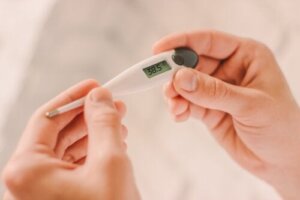How Does the Basal Temperature Birth Control Method Work?

The basal temperature birth control method is a form of family planning that estimates the time of peak fertility in women. It’s considered useful for monitoring menstrual cycles, since an increase in temperature is observed during ovulation. But how exactly does it work?
First of all, it’s important to remember that basal temperature is the temperature measured when the body is at rest. Therefore, to use it for planning purposes, it should be measured before getting out of bed each morning. It’s precisely with this monitoring that it’s possible to predict the best days to conceive. Let’s learn more about it.
What is basal temperature?
Basal temperature refers to the lowest natural body temperature that the body has when it’s in a state of rest, for example, during the period of sleep or just after waking up, before getting out of bed. In the case of women, it’s a parameter that undergoes variations during the menstrual cycle.
When ovulation occurs, progesterone secretion increases. This is one of the reproductive hormones involved in pregnancy. It also causes an increase in body temperature when the egg leaves the ovary. It’s estimated that this increase varies between 0.3 and 0.5 degrees Celsius.
Ovulation is the time that is associated with increased fertility and a greater chance of pregnancy. For this reason, keeping track of basal temperature throughout the cycle can be beneficial, especially for those who wish to conceive.
This measure estimates a woman’s most fertile days. Thus, the couple can plan sexual intercourse for those days when they intend to achieve pregnancy.
How is basal temperature measured?
Basal temperature should be measured upon awakening. This can be done in different ways: orally, vaginally, or rectally. Ideally, the same way should always be used and the temperature should be measured every day. In fact, it should even be done at the same time.
If taken orally, the thermometer should be placed under the tongue. Rectally, it’s recommended to introduce it slowly, using a lubricant to make it less uncomfortable. If the vaginal route is chosen, it can also be done this way.
It’s necessary to have slept for at least three hours. All data collected should be recorded day by day, from the time of measurement to the temperature itself.
How does this technique work?
The basal temperature planning method is currently widely used. According to a publication by the Mayo Clinic, it’s used to determine the best days to conceive or to know when not to have unprotected sex.
To do it correctly, it’s necessary that the woman keeps track of her temperature during several cycles. The point of greatest fertility occurs two or three days before the body temperature rises.
This is because sperm can live for almost 72 hours inside the female reproductive system. Therefore, once you know roughly when the day of the cycle the temperature rises, you can plan your sexual relations.
In fact, some couples use this method as a natural birth control, to determine which days they can have unprotected sex. However, this isn’t a recommended method on its own, as the risk of pregnancy remains high.
To avoid getting pregnant, other more effective methods are still preferable, such as condoms, which also protect against possible sexually transmitted diseases.
We think you may be interested in reading this, too: New Male Birth Contraceptive Pill Shows Positive Results in the Lab
Tips for birth control and pregnancy planning with the basal temperature method
To plan a pregnancy with the basal temperature method, it’s important to take certain aspects into account. As mentioned above, it’s essential to take your temperature every morning before getting out of bed. In addition, the body must have been at rest for at least three hours in a row.
Otherwise, it’s possible that variations in temperature may appear that don’t really correspond to ovulation. It’s recommended to always take it using the same method. That is, if you start vaginally, always do it this way.
According to a Planned Parenthood publication, the recording should be done every day. To make it easier, you can mark your temperature on a chart. On ovulation days, the temperature is a little higher and is maintained for about three days.
Some women use the basal temperature method to find out if they are pregnant or not. If the temperature remains elevated for more than 18 days, it may indicate pregnancy.
How to choose a good basal thermometer
The measurement of basal temperature has been refined in recent years. Some women use normal thermometers – the kind you usually have at home. However, there are more accurate thermometers that can be purchased for a reasonable price.
Thermometers that are marketed only for this method have specific characteristics. For example, digital thermometers usually have a memory. That is, it allows the previous temperature to be recalled. So, there’s no need to write it down on the recording sheet at that moment.
In addition, they’re usually very accurate. Thus, they can detect variations of a tenth of a degree. In general, they are easier to use than glass ones. Their main problem is that the battery tends to run out relatively quickly.
However, there are also different types of digital basal thermometers. One of the options is the Femometer smart basal thermometer. It has very high accuracy and can be synchronized with your phone via Bluetooth.
In addition, the memory reaches 300 days and the reading is done in about 90 seconds. Another option is the i-Snow Med multifunction digital basal thermometer. Its memory is smaller, but it has other useful features.
For example, it has a built-in alarm that helps set a reminder of when to take a temperature. It also features a backlit display that makes the readings easier.
Like this article? You may also like to read: How Long Can I Take Birth Control Pills?
The risks of the basal temperature method
The basal temperature planning method, when used to search for pregnancy, doesn’t carry any risks. However, it’s a method that requires patience and consistency. In addition, it requires availability to be able to have sex on the days of maximum fertility.
Logically, no contraceptive should be used at this stage if you want to get pregnant. On the other hand, when used to prevent pregnancy, it does involve risks. First of all, it’s essential to understand that this is not a precise method. Therefore, unwanted pregnancies may occur.
Likewise, it doesn’t protect against sexually transmitted infections, nor is it considered an effective contraceptive. For these reasons, its use isn’t recommended for this purpose.
Women who do seek to become pregnant should be aware that other factors can influence basal temperature. Stress, inadequate rest, or interrupted sleep cycles can also increase their body temperature.
The same is true when there is any type of illness that causes fever. Even drinking alcohol, traveling, or taking certain drugs can cause your basal temperature to increase.
What to remember about the basal temperature method
The basal temperature pregnancy planning method is simple and natural. It can help predict a woman’s most fertile days. In this way, one can try to synchronize sexual intercourse with those days to have a higher chance of pregnancy.
However, it must be done accurately and following certain tips. It should not be forgotten that this technique is not recommended as a contraceptive method, as it’s neither accurate nor effective. Before practicing it, it’s recommended to consult a gynecologist or a specialist. He/she will help to answer all of your questions.
All cited sources were thoroughly reviewed by our team to ensure their quality, reliability, currency, and validity. The bibliography of this article was considered reliable and of academic or scientific accuracy.
- Basal Body Temperature Method. (s. f.). USCCB. https://www.usccb.org/issues-and-action/marriage-and-family/natural-family-planning/what-is-nfp/science/basal-body-temperature-method
- ¿Cómo funciona el método de la temperatura? |Ciclo menstrual y días fértiles I Planned Parenthood. (s. f.). Planned Parenthood. https://www.plannedparenthood.org/es/temas-de-salud/anticonceptivos/metodos-basados-en-la-observacion-de-la-fertilidad-fam/en-que-consiste-el-metodo-de-la-temperatura-de-observacion-de-la#:~:text=Es%20m%C3%A1s%20baja%20en%20la,C%20y%2037.2%20%C2%B0C
- Oyelowo, T. (2007). Birth Control. En Elsevier eBooks (pp. 25-35). https://doi.org/10.1016/b978-032304601-5.50006-x
- Steward, K. (2022, 18 julio). Physiology, Ovulation And Basal Body Temperature. StatPearls – NCBI Bookshelf. https://www.ncbi.nlm.nih.gov/books/NBK546686/
- Temperatura basal para la planificación familiar natural – Mayo Clinic. (2023, 10 febrero). https://www.mayoclinic.org/es-es/tests-procedures/basal-body-temperature/about/pac-20393026
This text is provided for informational purposes only and does not replace consultation with a professional. If in doubt, consult your specialist.









